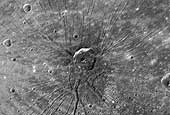|
COMETS EARTH JUPITER KUIPER BELT MARS MERCURY METEORITES NEPTUNE OORT CLOUD PLUTO SATURN SOLAR SYSTEM SPACE SUN URANUS VENUS ORDER PRINTS
PHOTO CATEGORIES SCIENCEVIEWS AMERICAN INDIAN AMPHIBIANS BIRDS BUGS FINE ART FOSSILS THE ISLANDS HISTORICAL PHOTOS MAMMALS OTHER PARKS PLANTS RELIGIOUS REPTILES SCIENCEVIEWS PRINTS
|
Related Documents
Download Options
The Narrow Angle Camera of the Mercury Dual Imaging System (MDIS) on the MESSENGER spacecraft obtained high-resolution images of the floor of the Caloris basin on January 14, 2008. Near the center of the basin, an area unseen by Mariner 10, this remarkable feature - nicknamed "the spider" by the science team - was revealed. A set of troughs radiates outward in a geometry unlike anything seen by Mariner 10. The radial troughs are interpreted to be the result of extension (breaking apart) of the floor materials that filled the Caloris basin after its formation. Other troughs near the center form a polygonal pattern. This type of polygonal pattern of troughs is also seen along the interior margin of the Caloris basin. An impact crater about 40 km (~25 miles) in diameter appears to be centered on "the spider." The straight-line segments of the crater walls may have been influenced by preexisting extensional troughs, but some of the troughs may have formed at the time that the crater was excavated. Credit: NASA/Johns Hopkins University Applied Physics Laboratory/Carnegie Institution of Washington |
